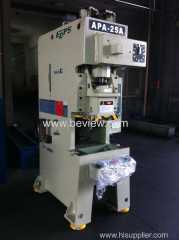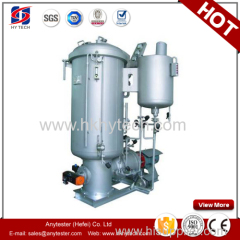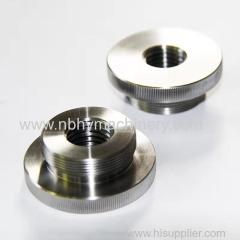|
Ningbo Yinzhou Hongyong Machinery Factory
|
cnc machined parts Hongyong Machinery
| Place of Origin: | Zhejiang, China (Mainland) |
|
|
|
| Add to My Favorites | |
| HiSupplier Escrow |
Product Detail
CNC Precision Machining for Transportation &Industrial Applications SUS 304 Csp Punching Parts
CNC Precision Machining for Transportation &Industrial Applications SUS 304 Csp Punching Parts
Customized Design
Sample Order Accepted
Short Delivery time
Competitive Prices
Long time quality Insurance
Professional after-sale services
100% responsibility for quality problems & Fast delivery
Packing according to customer requirements
T/T 30% prepaid and balance paid before shipment for
the first batch order
made in China

CNC machining parts is a widely used machining method in mechanical equipment manufacturing, which achieves precise machining of materials through computer programs and CNC machine tools. It has the advantages of high precision, high efficiency, and repeatability. This processing method can meet the processing needs of different components, including various materials and complex shapes, and is therefore widely used in various industries.
CNC machining parts refer to components manufactured through computer numerical control machining technology. This processing method utilizes computer programs to control mechanical equipment for automated processing, which has the advantages of high precision, high efficiency, and repeatability. CNC machining parts are widely used in various fields, such as automobiles, aerospace, electronic equipment, etc., providing key components for various industries.

cnc machined parts--A Guide to Frequently Asked Questions
1.What is the strength and rigidity of CNC machining parts, suitable for high load applications?
The ability of metal materials to resist elastic deformation under stress and The ability of metal materials to resist plastic deformation and fracture under external forces.
2.What is the role of CNC machining parts in the manufacturing industry?
Improving machining accuracy and quality,Improve production efficiency and efficiency
3.How about the maintainability and spare parts supply of CNC machining parts?
When the CNC system is not in use for a long time, the maintenance work should pay attention to the following two aspects:
1.the CNC system should be regularly powered on and running idle, so that the heat from the electronic and electrical components of the CNC system can be used to dissipate the moisture inside the CNC cabinet
2.The normal supply of spare parts is a guarantee measure to ensure the normal and uninterrupted operation of the system. Our company will provide spare parts for auxiliary equipment during the warranty period and random spare parts during equipment installation and debugging
4.What are the product skill training options?
1. Basic knowledge of CNC machining
2. CNC programming technology
3. Machining process and fixture design
4. Operating skills of CNC machining centers
5. Troubleshooting and maintenance
6. Safety operation and quality control
7. Application cases and practical operations

5.What are the common materials used for cnc machined parts?
Titanium, Aluminum, Stainless Steel, Copper/Brass, Iron, any types of alloy
6.Is CNC machining parts suitable for applications in high-speed motion and vibration environments, such as automotive engines or machine tools?
Yes, CNC machining parts are suitable for applications in high-speed motion and vibration environments. CNC machining parts are designed to be precise and durable, making them ideal for use in high-speed and vibration environments. CNC machining parts are also able to withstand high temperatures and pressures, making them suitable for use in automotive engines and machine tools.
7.How can CNC machining parts meet the needs of complex geometric shapes and micro dimensions, such as micro mechanical components?
Before preparing the CNC turning process, we need to first confirm the geometric shape and size of the parts to be processed, which requires accurate calculations. For complex shaped parts, CAD software can be used for design and drawing, and then extract the contour and control lines of the parts to be processed. Through these control points, the machining path can be confirmed, and then the CNC machine tool plan and program can be set up
8.How to ensure that the surface finish and quality of CNC machining parts meet the specification requirements?
1.selecting appropriate cutting parameters is the key to controlling surface roughness and smoothness
2.the selection and grinding of cutting tools also play an important role in controlling surface roughness and smoothness

9.How can CNC machining parts adapt to different hardness and processing requirements of materials, such as steel or plastic?
3. Reasonable selection of tool paths can improve machining efficiency and accuracy. When selecting, comprehensive consideration should be given to processing needs and material characteristics.
4. During the machining process, the stability of the workpiece should be ensured to prevent factors such as vibration from affecting the machining effect.
During the machining process, attention should always be paid to the wear of the cutting tools, and severely worn cutting tools should be replaced in a timely manner to ensure the machining effect.
When adjusting cutting parameters, comprehensive consideration should be given to factors such as material hardness, cutting depth, and the shape of the workpiece being processed to achieve the best effect.
10.How do CNC machining parts manage supply chain and inventory to ensure timely delivery and production planning?
1. Specify the warehousing standards for components
2. Warehousing of components
3. Review of component delivery notes
4. Quality inspection and acceptance
11.How can CNC machining parts cope with the manufacturing of non-standard or complex workpieces, such as reverse engineering or special shapes?
1.detailed design and modeling of the parts are required
2.Programming is a very important step in the machining process of CNC machine tools
12.How can CNC machining parts cope with applications in high vibration and impact environments, such as transportation equipment or vibrating screens?
Reduce the cutting force to the minimum;It is to enhance the static rigidity of the tool system or fixture with the workpiece as much as possible



























